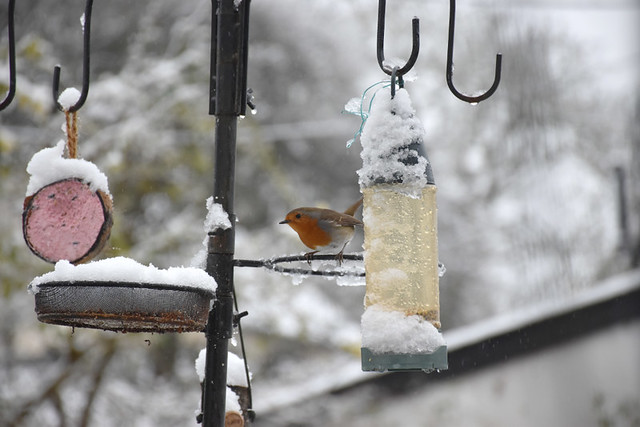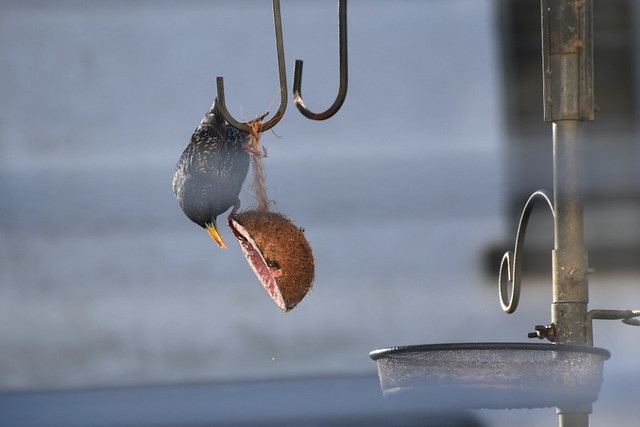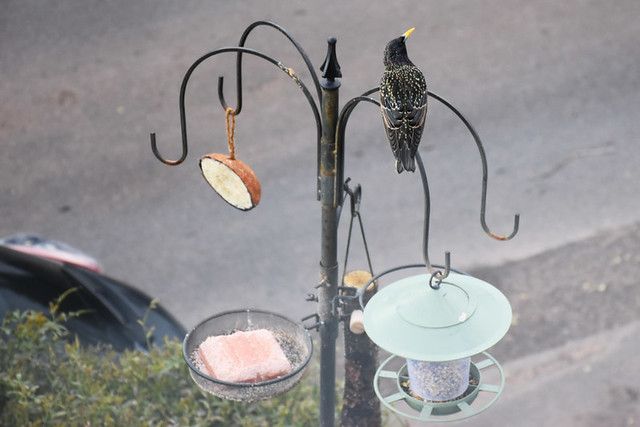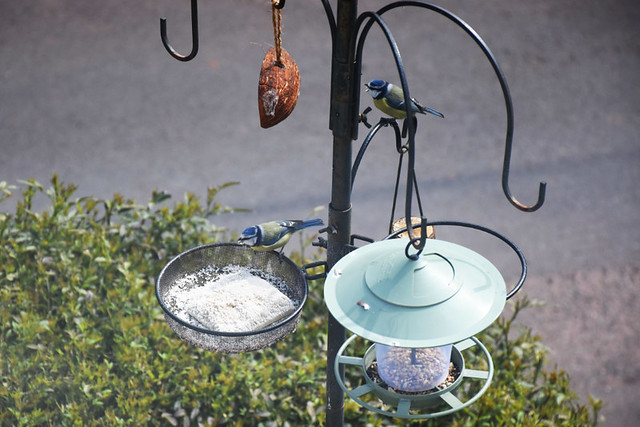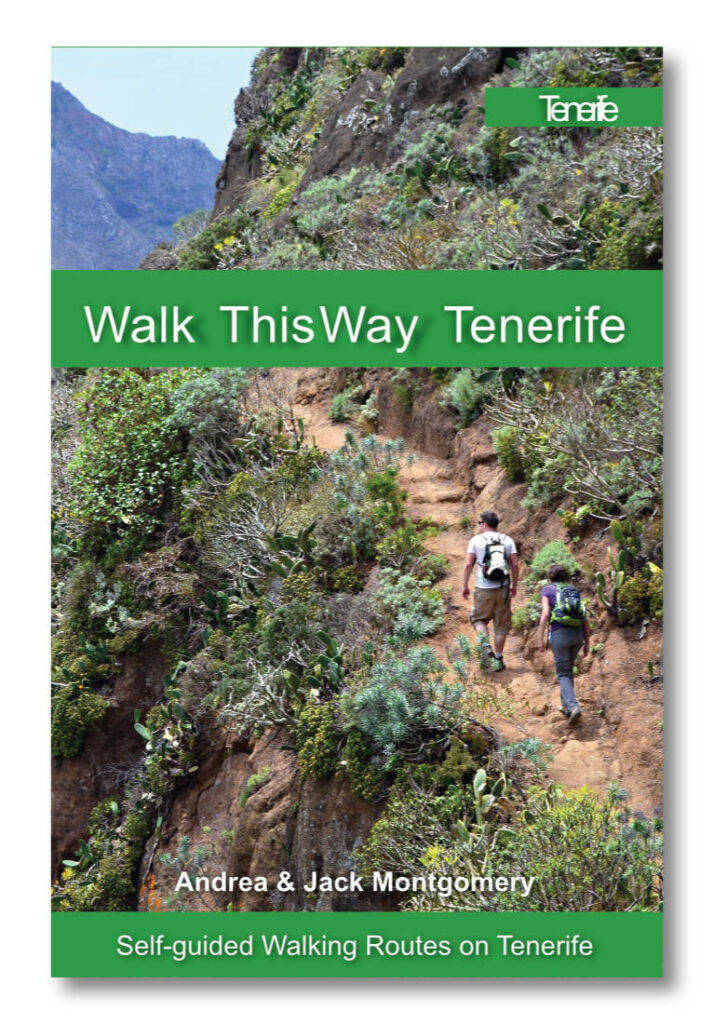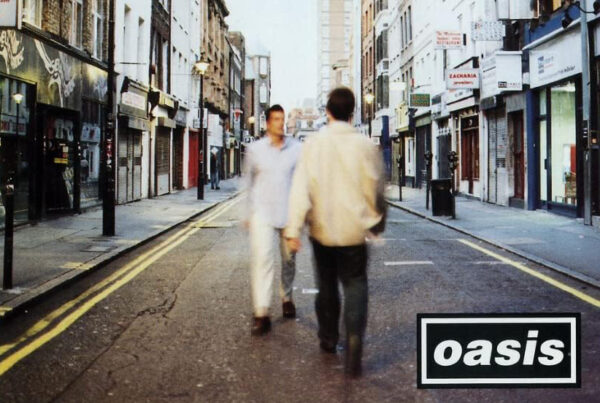‘Why have we never had a bird feeder before? It’s an endless source of entertainment.’
‘Well,’ Andy replied. ‘There were the cats in Stockport. Cats in Tenerife. And cats in Portugal.’
Cats. There were so many of them in both Tenerife and Portugal that having a bird feeder would have resulted in avian carnage.
Now we don’t have any cats, and we’ve inherited a bird feeder – basically a chain of self-service bird restaurants on a pole. There are cats. We’re surrounded by them. Although a couple have spent time casing the joint, taking scrupulous notes on peak bird eating times, none have figured out yet how to negotiate the thin iron pole. The birds are safe to come and go in safety … for now.

The old seed feeder – open to the elements and required good clinging abilities.
I’ve learnt a hell of a lot about running a bird restaurant in the last three months. For a start, different species have different preferences when it comes to what’s on offer.
Eating preferences
Blue tits, great tits, and long-tailed tits are the main users of the peanut fast-food joint (nuts behind a wire mesh in a dangling, hollowed-out branch). The tits and the starlings are the only patrons of the half-a-coconut filled with suet. Nobody else can hang on apparently. Sparrows hog the bird seed feeder. And all of the above, plus robins, frequent the mesh bowl where there’s a block of suet.
The suet is the only source of food for the robins as they don’t seem able to perch on anything else.
In terms of hierarchy, starlings are top of the tree. Sparrows travel in gangs, so take less notice of the bigger starling, unless there’s more than one dining. Cheeky tits don’t give a toss; they’ll muscle in whoever’s around. The timid robin is at the bottom of the chain, taking off into the adjacent forsythia bush, the favoured pre-dining venue of all small birds, the moment another bird appears.
Favourite flavours
I’ve also discovered birds have their favourite meals, just like humans. Suet is the steak of the bird food menu. Berry flavour is popular all round, coconut will do if there’s nothing else, and insect-flavoured suet causes a feeding frenzy. They’ll see a big wedge of it off in a couple of days. Whenever we’re heading off on a trip, we’ll stick a block of coconut suet in the tray, knowing it’s the only one with the chance of lasting a week.
Dining patterns
Here’s a question the birds have made me ponder. How did we (humans) establish the times we eat breakfast, lunch, and dinner?
Although specific times vary, especially between countries, there’s still a general pattern that remains the same. The reason I ask is that the birds’ feeding time tends to match ours. They turn up mob handed as we’re having breakfast. Then they head off to do whatever it is they do, appearing at around eleven when we take a break for a cup of tea. Then they’re off again, returning as we’re sitting down to lunch at around 13:00. We don’t have a break in the afternoon, so I don’t know if the birds do, but they congregate at their ‘favourite restaurants’ just before it goes dark, presumably for supper.
The other question their eating habits raise is this, why do they all arrive at the same time? You’d think it would make sense to organise different seatings for various species, that way the robins would get their fair share. But no, they all turn up en masse, which makes me wonder, when they finish eating do they all go somewhere and hang out together like a wee feathered gang until it’s time to eat again?
Renovating the restaurant
Thinking I was doing them a favour, I recently swapped the long, narrow bird-seed feeder tube because its trays were getting clogged up whenever it rained. I found the perfect replacement – a small, squat affair with a wide-brimmed roof (good for keeping the rain off the seeds in the trays) and a ring that circumnavigated the feeder. This ring seemed ideal for perching on and looked as though it could accommodate more birds.
Excited to see their reaction, I erected the new restaurant … and they completely ignored it. Day after day we checked, and nobody came. Our friend Sarah, visiting from New Zealand, even got hooked on bird eating habits. ‘Take the rest of their food away,’ she advised. But I didn’t have the heart to deprive the poor wee souls of food, especially as the weather was bobbins.
It was baffling. Everything about the feeder was a vast improvement on the old one, but the birds refused to go near it. Then the suet ran out and, taking our friend’s advice, we didn’t replace it.
Guess what? Now the new feeder is the most sought after joint on the block. There’s a queue of sparrows waiting to try out the hot new eating place in town, sometimes becoming irritated with loiterers who linger on the feeder after they’ve had their fill. As a result, squabbles are commonplace.
The birds love it. They were clearly just slow to accept change … just like humans.

